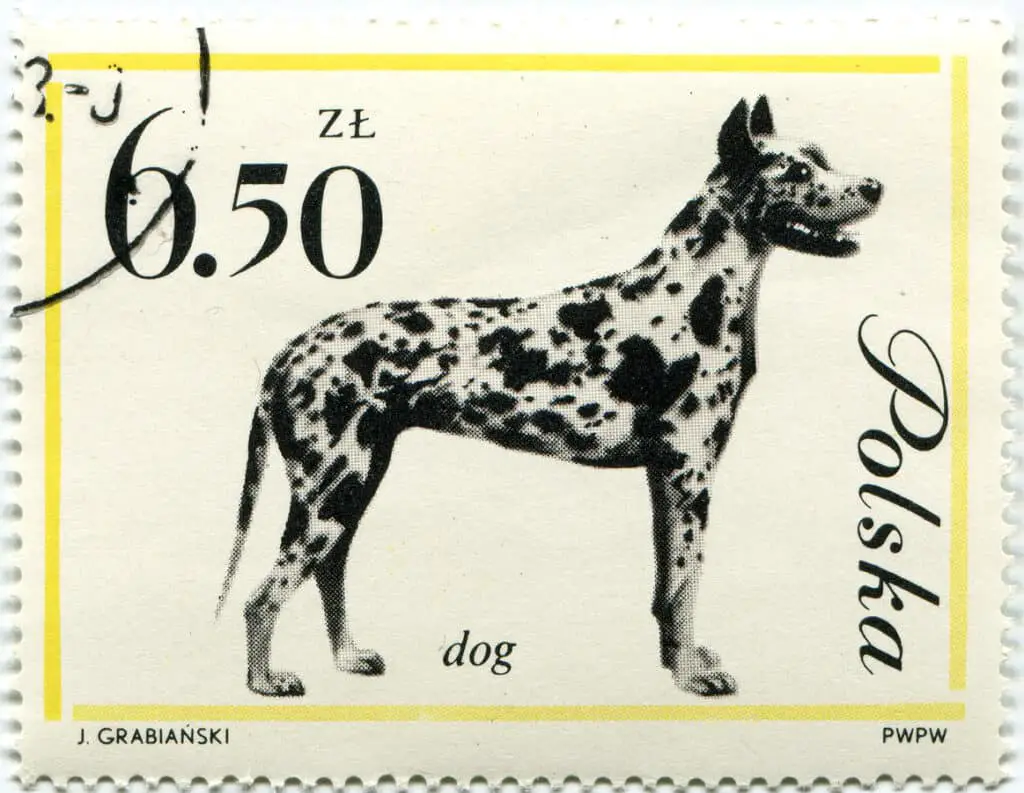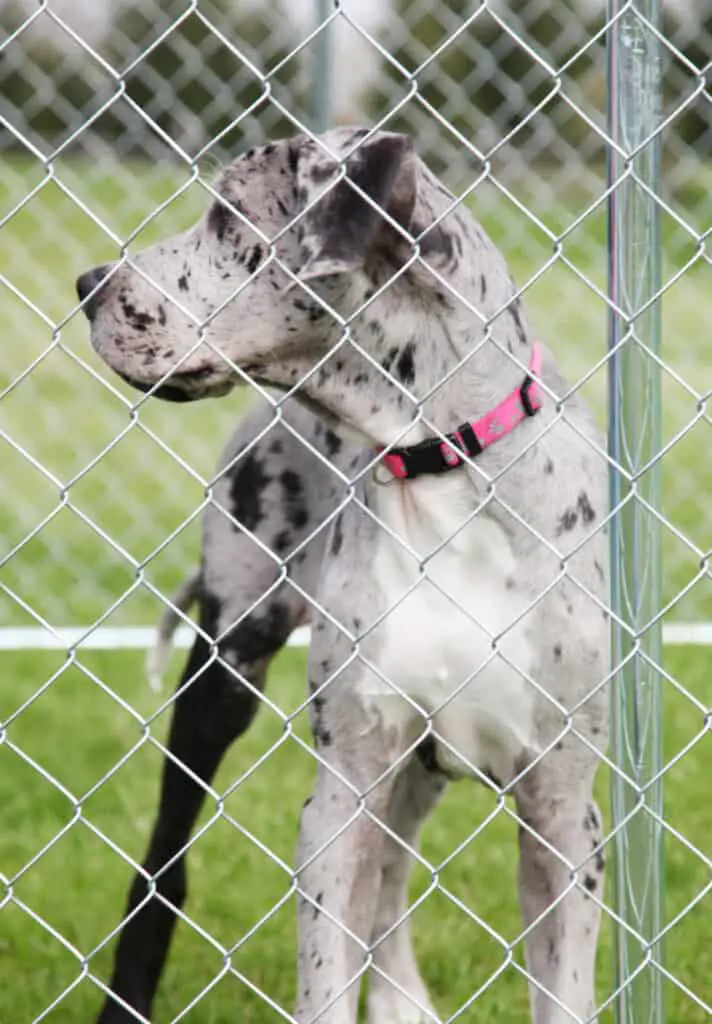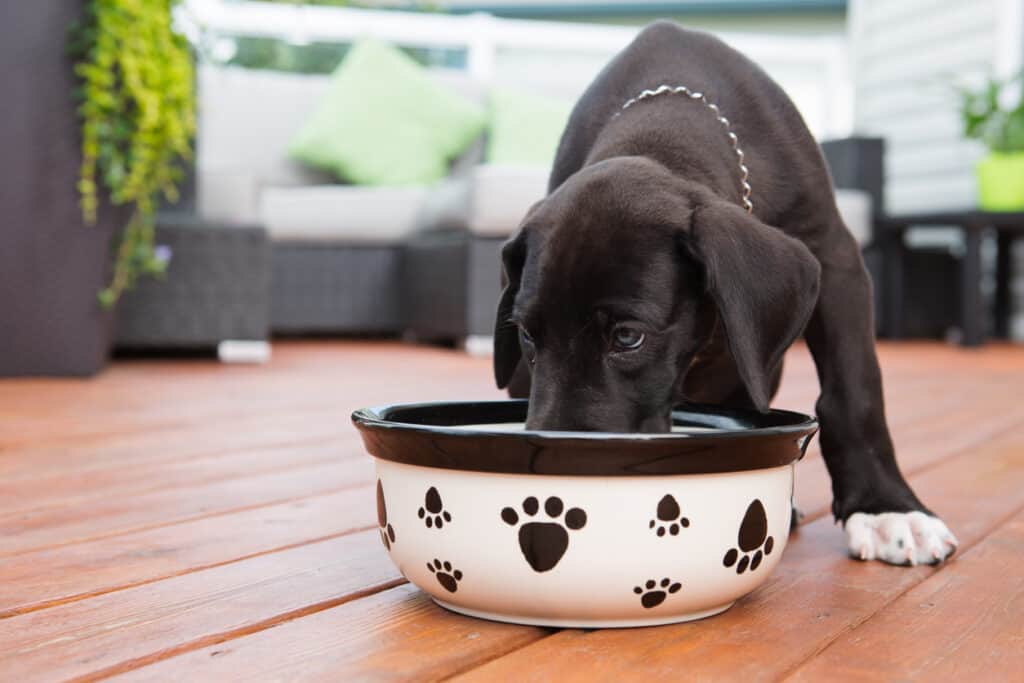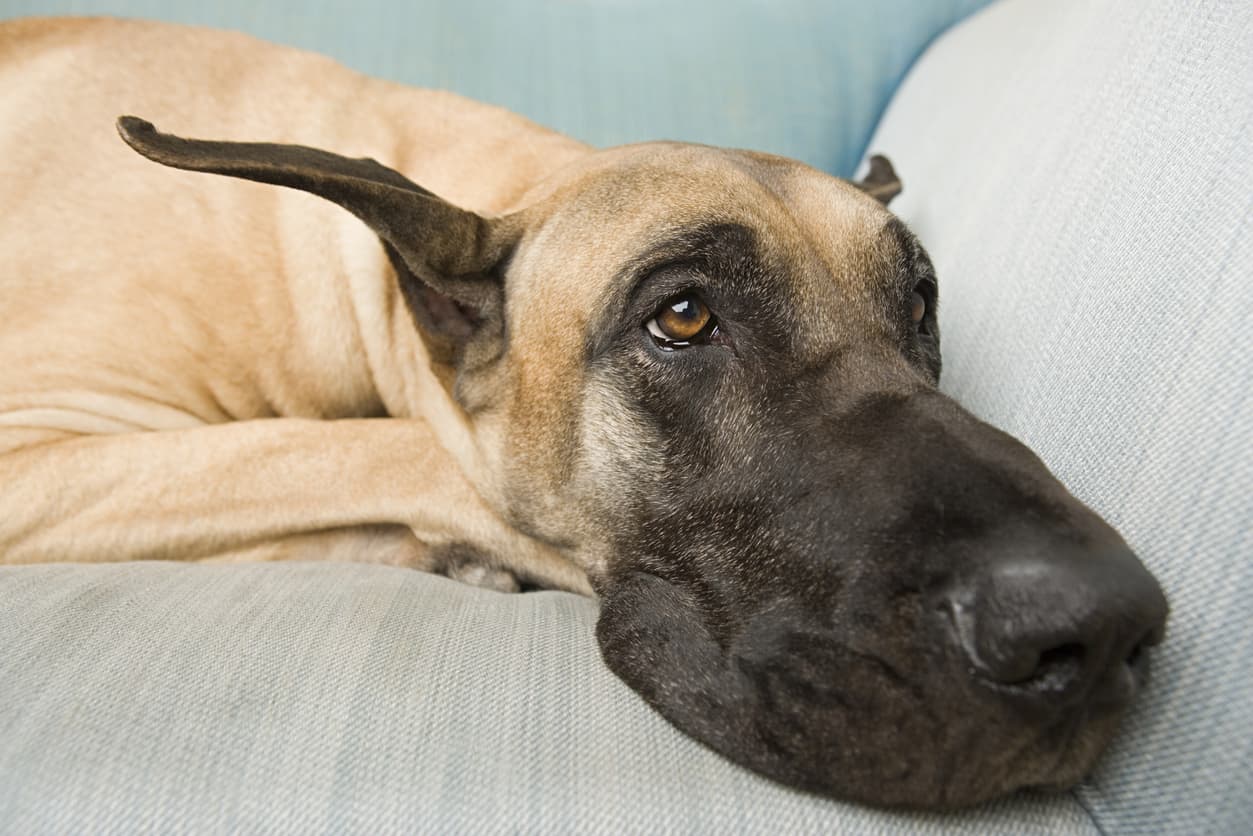Great Danes are one of the most popular large dog breeds in the world, but they are also one of the most expensive. Known as a wonderful family dog, this loyal and extremely attentive breed makes an excellent choice for people prepared to invest a lot of money into an animal that lives, on average, for seven to ten years.

Purebred Great Danes can cost anywhere from $400 to $3000 depending on the current market. Mixed Great Danes can sell for under $400, commonly sold around the $100 range.
The lifespan of a Great Dane is much shorter than many other dog breeds because its size and breeding make it prone to certain incurable illnesses. Fully grown, male Great Danes will stand at least 30-32 inches tall at the shoulder and females will be at least 28-30 inches, However, considering that this is a dog bred for size, the height of these animals is often much taller. Historically bred to hunt and catch wild boar in the forests of Germany, the Great Dane found another purpose as a protector in later generations, leading it to become the enormous guardian house pet it mostly is today.
While Great Danes make fabulous guard dogs, they are not the most affordable option for prospective buyers. People interested in purchasing a purebred Great Dane puppy should be aware that the price can vary widely, typically ranging between $400 to $3,000. Great Dane puppies that are advertised as purebred but sold for less should be considered with extra caution.
The reason for such a broad range is due to a number of factors that should be carefully considered by people who are looking to welcome a Great Dane into their home. For example, simple geographic location can play a large role because breeders operating in a high-cost area will charge more for their puppies than breeders in lower cost areas. The same goes for breeders operating in an area where Great Danes are a popular breed. Additionally, the wide array of Great Dane colors can also explain part of the range. Great Dane puppies that seem like a “deal” should be approached with extreme caution due to the fact that some people are only interested in capitalizing on the money to be made by breeding and selling Great Dane puppies.
Check your Seller

Unfortunately, because purebred Great Dane puppies can be sold for so much money, prospective owners need to be very careful about from whom they purchase their puppy. Pure bred puppies have suffered for years as the product of puppy mills or irresponsible backyard breeding, and in the case of the Great Dane, purchasing a puppy whose lineage cannot be clearly identified or traced means that its future health cannot be accurately predicted.
This is especially troubling when considering a breed such as the Great Dane that already comes with so many predispositions to health issues. For example, deficiencies such as cherry eye or deafness are passed down genetically, but they are naturally predisposed to hip dysplasia and other joint problems. In some cases, even the color of a puppy can predict future health issues, so it’s important to self-educate as much as possible with the help of veterinarians, reputable breeders, and research.
After you’ve worked to identify a trustworthy Great Dane breeder, it’s time to decide whether you’re interested in owning the Great Dane just as a family pet, or if you’re interested in raising it to be a show dog too. Prospective dog owners will want to think carefully, because their decision will have serious financial implications that will last throughout the Great Dane’s life.
If you simply love the breed and just want to have a Great Dane for a pet, you will not be constrained to the six accepted Great Dane colors nor need to do additional research regarding the genealogy of your Great Dane puppy. Great Dane puppies bearing one of the six acceptable show coats (black, brindle, blue, fawn, harlequin, mantle, and, most recently, merle) will be much more expensive than other colors, such as chocolate, merlequin, or fawnequin.
Prospective owners who want one of the six official show colors but are not interested in showing their Great Dane should read up on Great Dane colors and how the coats are judged so that they can negotiate a fair price for a puppy that perhaps has one of the coat colors, but not in its most desirable expression. Certain nose colors are also unacceptable in the show ring, which can provide another avenue for price negotiation.
Great Dane’s Bloodline

If you are interested in showing your Great Dane, you will likely want to invest in a puppy from a top-of-the-line breeder, which, depending on where you live, will almost definitely put you out over $1000. In the most expensive areas, a Great Dane puppy from exceptional bloodlines by parents who have won in the show ring may even cost as much as $5,000. Again, here is where the need for a knowledgeable, seasoned, and trustworthy breeder becomes evident. Your breeder should be passionate about Great Danes and first and foremost committed to producing healthy puppies that positively contribute to the gene pool of living Great Danes.
Any claims regarding the quality of the bloodline should be substantiated by documentation and the presence of both the bitch and the dog who created the litter. Breeders should also be receptive to and enthusiastic about answering your questions. If you’re not sure where to start, you can go to the American Kennel Club’s website to look for AKC certified Great Dane breeders, or simply visit your local veterinarian and ask for recommendations. These options will provide you with objective and honest recommendations that best serve the interests of you and your future puppy.
After you’ve identified a breeder you want to work with, decided whether or not you want to show your Great Dane, and picked out your Great Dane puppy, it’s time to make some more financial decisions. If you plan to show your Great Dane, you will need to register your puppy with the American Kennel Club. As you enter the community of Great Dane owners, you may encounter a pressure or expectation to crop your puppy’s ears. This stems from an old tradition of cropping the Great Dane’s ears so that it’s ears wouldn’t get torn up in a fight with a boar or other animal. It’s important for prospective owners to be aware that regardless of whether certain judges have a preference for cropped ears, they are not mandated by the standard, so by abstaining you are saving yourself a lot of money. Cropping the ears of a Great Dane puppy is a lengthy and costly process, totaling on average around $500. Additionally, many would also argue you are saving your puppy from unnecessary pain.
Cost of Owning a Great Dane
Besides the up-front costs such as the price of the Great Dane puppy itself, there are other costs associated with owning a Great Dane. Of course, all puppies require basic supplies such as a crate, food, water, and toys, but Great Danes require much more than a standard puppy.
By the time you bring your Great Dane puppy home, it will already weigh about 20 pounds (females may weigh a little less, males a little more). You will spend a lot of time in consultation with your veterinarian during that first year –vaccinating your puppy, attending regular check-ups, and planning a feeding schedule. Great Dane puppies have very particular dietary needs to ensure that their growth is steady and sustainable, but the bottom line is simple: they need a lot more food than your average puppy.
Great Dane puppies are not grown and completely filled out until around three years of age, at which point the food bill levels off to somewhere around $100 a month. Bear in mind that this is not an exact number and that the amount you spend feeding your Great Dane will depend on a variety of factors such as whether you have a female or a male (females are usually smaller than males and so eat a bit less) and on the energy level of your Dane.
All Great Danes require easily accessible toys to chew on, otherwise they have been known to turn to furniture to fill that need. Great Dane puppies also have very specific dietary requirements with regard to the amount of protein and micronutrients such as calcium and phosphorous in their food, making it extra important for owners to purchase high-quality food.
If you do not plan to show your Great Dane, you may want to consider neutering or spaying your puppy. It is recommended to wait until your male puppy is at least one year of age and until your female puppy has gone through one heat cycle so that the puppy’s hormones are not disrupted by the procedure. As is the case with every animal, spaying will cost more than neutering, however, females tend to be calmer and easier to train, so the difference in sterilization procedures may prove insignificant when considered over the long term. However, it is still a cost to be mindful of. Typically it will cost somewhere between $125 and $400 to neuter a puppy, whereas a spay will run you about $200 to $600.
Another cost associated with bringing a Great Dane puppy into the home is the need for obedience training. Although Great Danes tend to be docile and trainable by nature, their size makes quality training a necessity, which may mean investing in a canine training course for your Dane a necessity. This is especially important early on because a Great Dane puppy that is not properly trained could become an anxious and volatile Great Dane requiring many hours of retraining.
Great Dane Puppy Cost
Great Dane puppies also need a larger-than-standard crate, and many owners opt to purchase the full-size crate up front so as to avoid the costs associated with purchasing multiple crates for the different stages of puppy growth. While this is a wise move financially in the long run, up front, a dog cage the appropriate size for an adult Great Dane will cost somewhere in the neighborhood of $200. Additionally, a full-size crate is not appropriate for a Great Dane puppy that will need to be potty trained, so about half the crate will need to be partitioned off so that only the front part is accessible. This is important because Great Danes, like all dogs, typically dislike going to the bathroom where they sleep and rest, so by ensuring that the amount of crate space your Great Dane puppy has is appropriate for their size, you are helping facilitate their potty training.
If you’ve calculated that you can afford the cost of purchasing a purebred Great Dane puppy and the associated feeding and training costs, it’s time to consider whether you have a lifestyle that is compatible with the long-term health of a Great Dane. As previously mentioned, Great Danes take a long time to reach full physical maturity, meaning that it’s extremely important to monitor supervise their diet. Great Danes whose diets are not properly supervised as puppies are at exacerbated risk of developing Wobbler’s syndrome, which is a growth-related disease causing spinal compression in the neck vertebrae that results in an odd gait that is unhealthy for the animal and unacceptable in the show ring. A Great Dane that develops Wobbler’s syndrome will need veterinary attention and likely medication, possibly surgery depending on the severity of the condition.
If you’re able to safely guide your Great Dane through their prolonged growth period, they remain prime candidates for developing an emergency medical condition known as bloat. Bloat can occur under many different circumstances, such as eating too quickly or exercising too soon after eating, and it happens when the stomach flips on its axis and twists, resulting in the cutoff of blood flow to vital organs. This is always an emergency condition that requires veterinary intervention. Sometimes the condition is treatable with medication, other times, it requires surgery.
Great Dane Surgery Costs
Another medical factor to consider when considering how much a Great Dane costs is the size of its heart. Great Danes literally have huge hearts, which predisposes them to heart disease. The condition is manageable with medication, but the monthly expenses for it can range from $500 to $1,500 each month.
Because of the multitude of ailments that can afflict a Great Dane even under the best of circumstances, many people choose to either enroll in pet insurance or factor in a “rainy day” fund for their Great Dane when calculating a monthly budget. All in all, Great Dane owners are looking at monthly costs of somewhere between $100 and $350 depending on many factors such as whether or not their Dane requires medical treatment or is insured.
Great Danes make wonderful family pets and owners will be quick to tell you that the breed is worth every cent invested in its livelihood –but the costs associated with buying a purebred Great Dane should not be understated. This is a breed that is for an owner in a secure financial position that can meet the animal’s (sometimes very serious) needs throughout its entire life. For prospective owners that want to be responsible about their ability to meet their desired breed’s need throughout its life, working with a trustworthy organization to adopt a Great Dane can be a wonderful and fulfilling means of finding the Great Dane that’s right for your circumstances.

